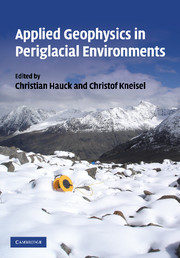Book contents
- Frontmatter
- Contents
- List of contributors
- Introduction
- Part I Geophysical methods
- Part II Case studies
- 5 Typology of vertical electrical soundings for permafrost/ground ice investigation in the forefields of small alpine glaciers
- 6 ERT imaging for frozen ground detection
- 7 Electrical resistivity values of frozen soil from VES and TEM field observations and laboratory experiments
- 8 Results of geophysical surveys on Kasprowy Wierch, the Tatra Mountains, Poland
- 9 Reassessment of DC resistivity in rock glaciers by comparing with P-wave velocity: a case study in the Swiss Alps
- 10 Quantifying the ice content in low-altitude scree slopes using geophysical methods
- 11 The use of GPR in determining talus thickness and talus structure
- 12 GPR soundings of rock glaciers on Svalbard
- 13 Arctic glaciers and ground-penetrating radar. Case study: Stagnation Glacier, Bylot Island, Canada
- 14 Mapping of subglacial topography using GPR for determining subglacial hydraulic conditions
- 15 Snow measurements using GPR: example from Amundsenisen, Svalbard
- 16 Mapping frazil ice conditions in rivers using ground penetrating radar
- Appendix: Tables of geophysical parameters for periglacial environments
- Index
- Plate section
- References
10 - Quantifying the ice content in low-altitude scree slopes using geophysical methods
Published online by Cambridge University Press: 22 August 2009
- Frontmatter
- Contents
- List of contributors
- Introduction
- Part I Geophysical methods
- Part II Case studies
- 5 Typology of vertical electrical soundings for permafrost/ground ice investigation in the forefields of small alpine glaciers
- 6 ERT imaging for frozen ground detection
- 7 Electrical resistivity values of frozen soil from VES and TEM field observations and laboratory experiments
- 8 Results of geophysical surveys on Kasprowy Wierch, the Tatra Mountains, Poland
- 9 Reassessment of DC resistivity in rock glaciers by comparing with P-wave velocity: a case study in the Swiss Alps
- 10 Quantifying the ice content in low-altitude scree slopes using geophysical methods
- 11 The use of GPR in determining talus thickness and talus structure
- 12 GPR soundings of rock glaciers on Svalbard
- 13 Arctic glaciers and ground-penetrating radar. Case study: Stagnation Glacier, Bylot Island, Canada
- 14 Mapping of subglacial topography using GPR for determining subglacial hydraulic conditions
- 15 Snow measurements using GPR: example from Amundsenisen, Svalbard
- 16 Mapping frazil ice conditions in rivers using ground penetrating radar
- Appendix: Tables of geophysical parameters for periglacial environments
- Index
- Plate section
- References
Summary
Introduction
In many periglacial applications ground ice detection and quantification is the major objective. Typical examples are low-altitude scree slopes, which are covered with blocky material and may contain ground ice throughout the year far below the regional limit of permafrost due to microclimatic conditions that resemble those of high-altitude periglacial areas (see Sawada et al. 2003, Delaloye et al. 2003, Delaloye and Lambiel 2005, Zacharda et al. 2007). Essential preconditions for this extraordinary microclimatic phenomenon are assumed to be a thick layer of blocks with an open void system, i.e. steep slopes with almost no fine material. Summer ice observations and cold air outflow from the blocks in the near subsurface, as well as the occurrence of cold-adapted mosses and different invertebrate groups (e.g. beetles and spiders) that normally live in high alpine or polar areas are used as indicators for the possible presence of ground ice (Gude et al. 2003, Zacharda et al. 2005). The ‘thermal semi-conductor’ effect of the coarse rocks is also widely used in construction, e.g. for the permanent cooling of railroad embankments in permafrost regions (Cheng et al. 2007).
However, whether significant ice occurrences could be permanently present within the scree slopes is still an open question. Delaloye and Lambiel (2005) describe a cold ventilated talus slope in the Swiss Alps, where sediments more or less saturated with ice were found at 7–8 m depth during construction of two cable car pylons.
- Type
- Chapter
- Information
- Applied Geophysics in Periglacial Environments , pp. 153 - 164Publisher: Cambridge University PressPrint publication year: 2008
References
- 8
- Cited by



